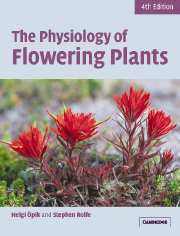Book contents
- Frontmatter
- Contents
- Preface
- Chapter 1 Introduction
- Part I Nutrition and transport
- Part II Growth and development
- Chapter 6 Growth as a quantitative process
- Chapter 7 Plant growth hormones
- Chapter 8 Cell growth and differentiation
- Chapter 9 Vegetative development
- Chapter 10 Photomorphogenesis
- Chapter 11 Reproductive development
- Chapter 12 Growth movements
- Chapter 13 Resistance to stress
- Appendix
- Index
- References
Chapter 12 - Growth movements
Published online by Cambridge University Press: 05 June 2012
- Frontmatter
- Contents
- Preface
- Chapter 1 Introduction
- Part I Nutrition and transport
- Part II Growth and development
- Chapter 6 Growth as a quantitative process
- Chapter 7 Plant growth hormones
- Chapter 8 Cell growth and differentiation
- Chapter 9 Vegetative development
- Chapter 10 Photomorphogenesis
- Chapter 11 Reproductive development
- Chapter 12 Growth movements
- Chapter 13 Resistance to stress
- Appendix
- Index
- References
Summary
Introduction
Although it is a general perception that plants do not move very much, or very quickly, this is true only when seen from a human perspective. If we view the world using time-lapse photography we quickly become aware that all plants are, more or less, in continuous motion. This should not come as a surprise when one considers that plants cannot uproot themselves and relocate to a new environment to maintain suitable conditions; they must orientate their organs, largely by growth, to optimize their interactions with the non-uniform environment which surrounds them. We tend to take it for granted that shoots (usually) grow upwards into the air and roots grow down into the ground; leaves spread out and turn to the light; flowers take up specific orientations. All this positioning is the result of differential growth, growth movements, in precise and complex responses to environmental stimuli, especially light and gravity. Mutants which lack some of these responses are unable to grow normally; e.g. mutant shoots unable to respond to gravity lie on the ground and in the field would be overgrown and perish. Growth movements, imperceptible as they are to instantaneous observation, are vital to the plant. In addition to the relatively slow growth movements, more rapid, visible movements are exhibited by specialized plant organs.
- Type
- Chapter
- Information
- The Physiology of Flowering Plants , pp. 318 - 343Publisher: Cambridge University PressPrint publication year: 2005



